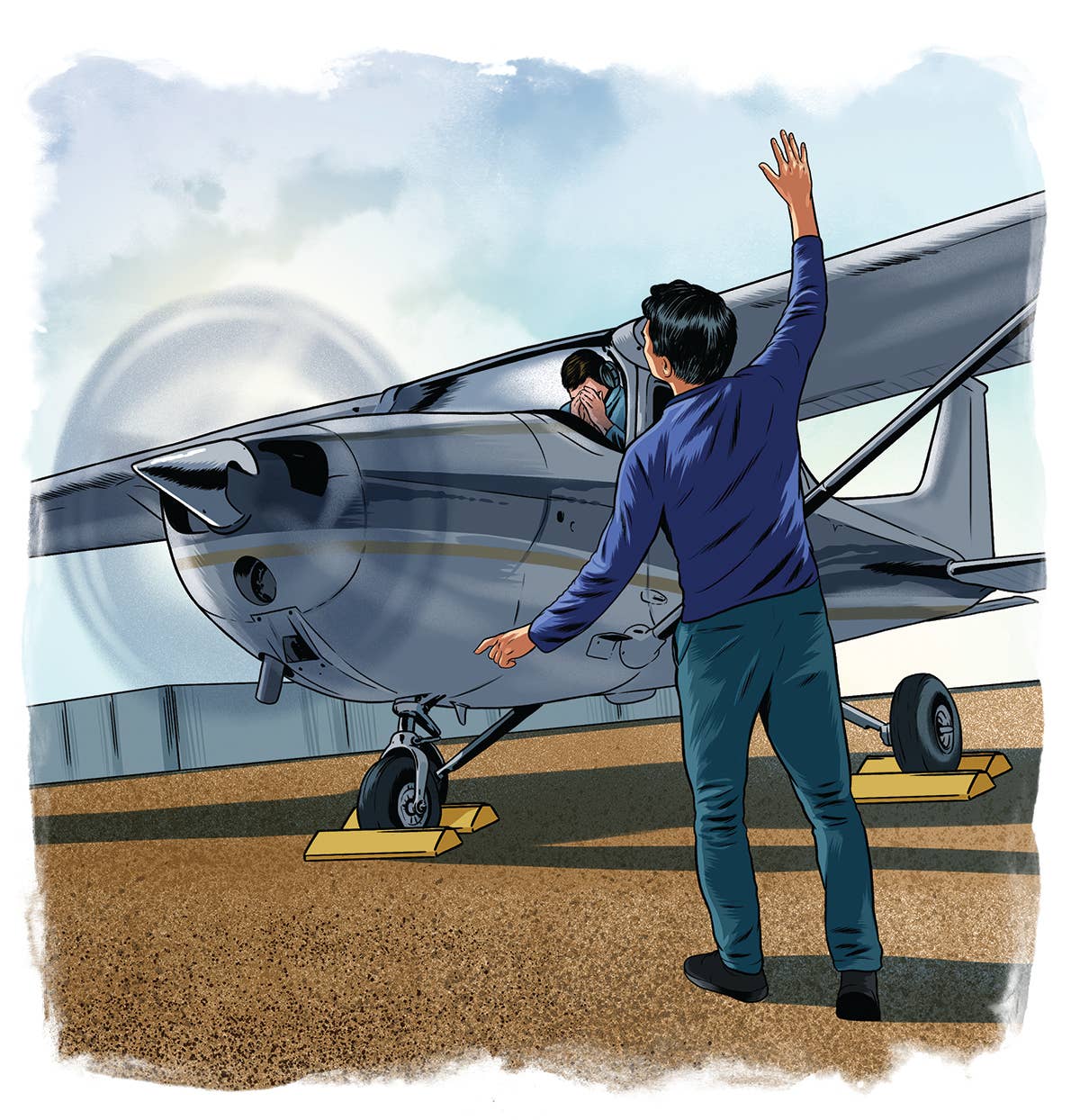Leaving in the Chocks
Bill Kershner thought that most everyone in aviation has had a humorous experience with those devices used to keep an airplane from rolling on the ground. I believe that Bill was correct; I certainly have my own.

Most everyone in aviation has a humorous memory that they can never live down. [Illustration by Joel Kimmel]
My friend, the late Bill Kershner, who encouraged me to write my flight testing book, wrote his own book titled Logging Flight Time, published by Iowa State University Press. It’s about Bill’s humorous experiences during his flying career. In that book he had a chapter entitled “Chocks.” Bill thought that most everyone in aviation has had a humorous experience with those devices used to keep an airplane from rolling on the ground. I believe that Bill was correct; I certainly have my own.
After spending 10 years in the industry as a test pilot and having had to exit two test airplanes via ‘nylon letdowns’—also known as parachutes—I decided that academia might be a little less hazardous. So I became a professor of aviation systems at the University of Tennessee Space Institute in Tullahoma, Tennessee, where I became friends with Bill, who lived in Sewanee about 20 miles away.
If you're not already a subscriber, what are you waiting for? Subscribe today to get the issue as soon as it is released in either Print or Digital formats.
Subscribe NowThe fellow who ran the FBO in Tullahoma (KTHA) at the time was Walt Harris. Walt had been a pilot for the State of Tennessee when Winfield Dunn was the governor. Walt had been his pilot and, as a result, believed that you could accomplish almost anything with politics. Walt also felt that the Tullahoma Airport needed an FAA-designated pilot examiner. After his efforts to encourage the FAA’s Nashville Flight Standards District Office (FSDO) to appoint one were unsuccessful, Walt went the political route by contacting his congressman.
The FAA does respond to political pressure, and before long, the Nashville FSDO contacted Walt telling him they would appoint someone, but that he needed to come up with the names of three people for them to evaluate. Walt, of course, wanted the job for his flying school. I became involved when Walt showed up in my office at the university’s facility at the airport, asking if I would submit my name for the evaluation. I have been an FAA-designated engineering representative (DER) test pilot since 1971, and this was 1980. Not really wanting to be a pilot examiner, I went along for Walt’s sake to be one of his three names. The other individual in the “hunt” was Jerry Ritchie, who had previously worked for the FAA as an inspector and was running an auto parts business in Tullahoma.
Several weeks later, I received a call from Walt telling me that the FAA would be in Tullahoma on a certain day for the evaluation, which would include an oral exam and a check ride. On the appointed day, I showed up at the FBO with the requisite paperwork filled out, but with no preparation for the oral examination or the check ride since I did not want the job.
The FAA had flown with Walt in the morning after they arrived, and they would fly with Jerry Ritchie and me after lunch. The oral exam consisted of a review of my paperwork and a few questions about my background, which was conducted by Lonnie Thurston (who has since retired).
After the brief oral, he said, “Let’s go fly.” He also said we would not need a preflight inspection since “we flew the airplane twice this morning, and it was okay.” I normally do not trust people I do not know well with my preflight inspections, but since he was the FAA—and I didn’t care about being a pilot examiner—I let it go. We climbed into the Cessna 172 that was to be used for the check ride, and I started the engine. Lonnie had told me what he wanted to do during the oral exam, so I proceeded to add power to taxi. The airplane did not seem to roll with what I thought should be enough power to taxi, but it had been a while since I had flown a Cessna 172, so I added more power. Still nothing happened.
About that time, Jimmy Chapman, the line boy at Tullahoma—now part owner in the FBO—came running out of the FBO waving his arms and pointing at the wheels. I then realized I had not pulled the chocks from the main wheels. Feeling like a complete fool, and knowing I was for sure not going to be a pilot examiner, the remainder of the ride went uneventfully. Upon com- pleting the flight, Lonnie told me they would let me know who would be designated in a couple of days. I was pretty sure it would not be me.
Much to my surprise, a few days later, Lonnie called to tell me that they were designating two pilot examiners in Tullahoma and that I was to be one of them. The other one was Jerry Ritchie.
I served as a DPE in Tullahoma for 25 years, issuing pilot certificates for private, commercial, instrument, and multiengine pilots. However, I never did find out what Walt had done that caused me to be designated instead of him. I was sure I had blown the check ride when I forgot the chocks.
It could be the FAA responds to political pressure—but not always in the way you would like.

Subscribe to Our Newsletter
Get the latest FLYING stories delivered directly to your inbox







